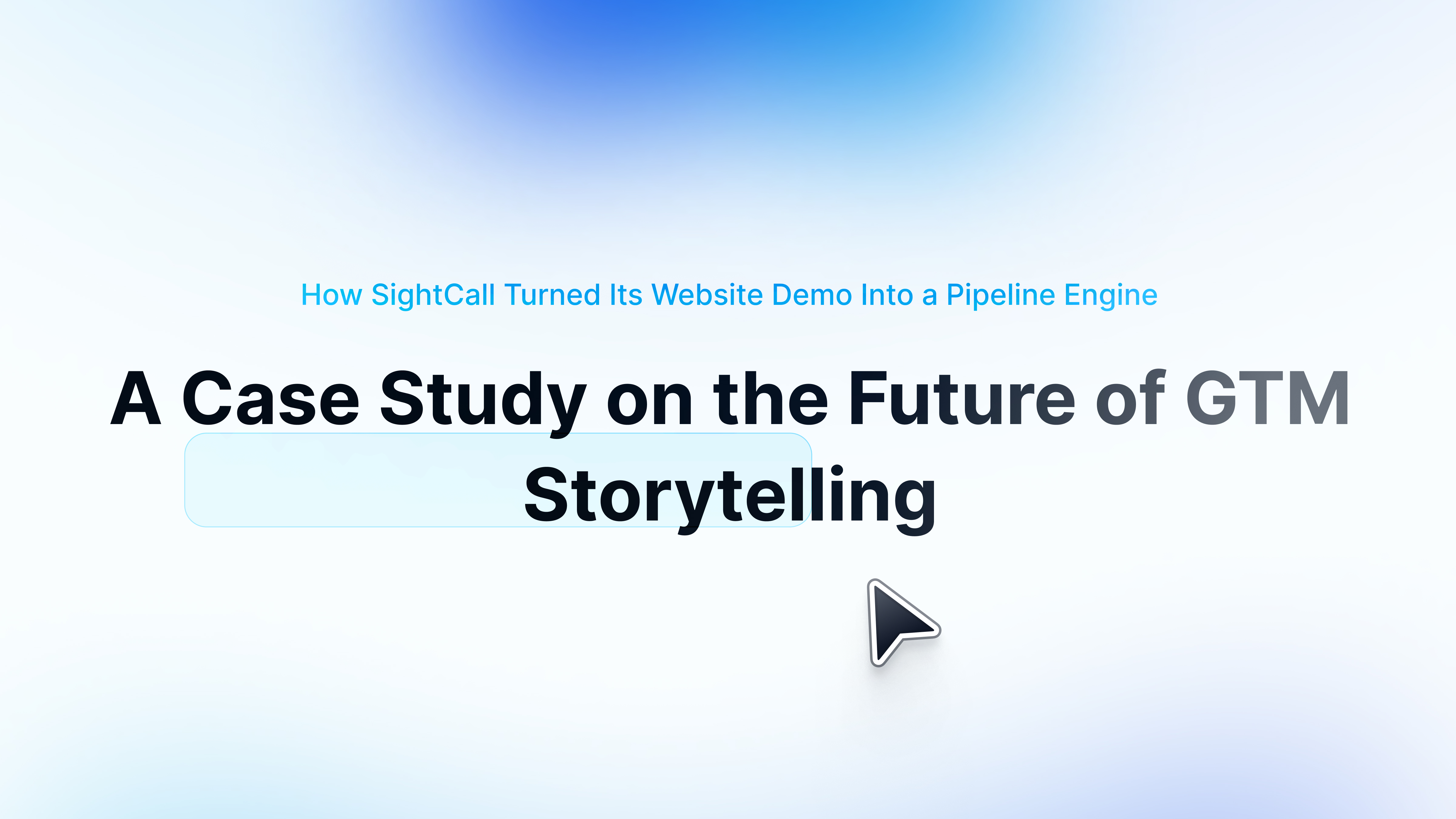TL;DR: Interactive demos shift the model from “telling” to letting buyers experience value for themselves. When prospects can explore your product instantly, they understand the narrative faster and enter conversations with stronger intent.
- SightCall moved to a self-guided, interactive demo and saw immediate results. Their Arcade demo became the number one pipeline driver on their website and helped double pipeline in a single quarter.
- The real unlock wasn’t the demo itself — it was the workflow behind it. Desktop recording, AI hotspots, auto-updating embeds, and instant translations allowed SightCall to update demos, documentation, and regional assets in hours instead of days.
- GTM teams who adopt this workflow gain speed, clarity, and consistency across every touchpoint. The product story stays aligned across regions, sales cycles accelerate, and buyers get the experience they expect in 2025.
If your product story feels harder to maintain than the product itself, you’re not alone. GTM (Go-to-Market) teams everywhere are running into the same friction: demos that go stale, workflows that rely on too many people, and buyers who want to see the product now but rarely get that chance.
The real blocker isn’t creativity. It’s the workflow behind your demo process.
Some teams keep adding more videos, more decks, and more hands to the process. Others are moving toward a model where demos update as fast as the product, and buyers can explore what they need without waiting for a call.
SightCall made that shift, and the impact was striking. Their interactive demo became the number one pipeline driver on their website and helped double pipeline in a single quarter.
Here is what their story reveals for GTM teams everywhere.
The Demo Problem Most GTM Teams Don’t Talk About
Even the strongest product story will fall flat if the assets behind it can’t keep up. Most GTM teams are still navigating demo workflows designed for a slower era of software. That creates pressure that compounds over time.
Here are the most common friction points:
- Static videos become stale too quickly. Product UI changes, new features ship, and old recordings misrepresent the experience. A video that took hours to produce can feel outdated within weeks.
- Decks end up scattered across functions and regions. Sales uses one version, marketing uses another, and international teams spin up their own. The result is inconsistent storytelling that creates confusion for buyers.
- Asset updates drain time and focus. Every product release triggers a cascade of re-recording, editing, uploading, and alignment meetings. Teams spend more time maintaining demos than using them.
- Websites hide the product behind a form. Buyers want to explore immediately. When their first touch is a “talk to sales” CTA, most drop off before they see the value.
- Documentation workflows slow everything down. Screenshots, step-by-step visuals, and help center updates take hours to refresh, which creates friction for CS and support teams.
This is not a content problem – it's a workflow problem. Most teams already know what they want to say, but they're not equipped to update it fast enough or keep it consistent across channels. When the workflow becomes lighter and more flexible, the content naturally becomes clearer, sharper, and more effective.
The Shift: From “Telling the Story” to Letting Buyers Experience It for Themselves
Interactive demos create a new foundation for cross-functional alignment. SightCall’s turning point was not realizing they needed better demos, but instead seeing how much time they were losing trying to maintain them.
Before coming across and implementing Arcade into their workflows, their teams were juggling:
- Full demo re-recordings every time the UI changed. A small design update could mean hours of new production work.
- Regional requests that required manual duplication. EMEA teams needed localized assets, which created additional versions to maintain.
- Sales requests for persona-specific demos. Each variant added to the production backlog and introduced more inconsistency.
- Documentation builds that were slow to publish. Screenshot updates could delay launch timelines or leave help centers out of date.
After adopting Arcade, however, that cycle broke. Not, they had tools that reshaped how demos were created and maintained:
- Desktop recording that captured the full SightCall experience: The team could finally record everything, including the live video plugin that other tools struggled with.
- AI hotspots that generated clean, accurate explanations: Instead of typing callouts line by line, PMM received polished step copy instantly.
- One-click screenshot exports for documentation: Release notes and help articles could be refreshed in minutes instead of hours.
- Auto-updating embeds that synced global sites: A single source of truth meant US and EMEA teams could rely on the same up-to-date experience.
- Instant translations for localized product stories: Regional teams no longer waited on external translation vendors to launch new content.
The workflow became lighter, the story became clearer, and buyers finally got to explore what SightCall’s product could do for them without waiting for a meeting, regardless of specific use case needs.
“Arcade made it possible to keep output velocity and quality high. For me, it created a two to three times time savings.” - David Swift, VP of Product Marketing, SightCall
Why Buyer-Led Exploration Outperforms Traditional Demos
Once SightCall placed its interactive demo on the website, the shift in buyer behavior was immediate. And results speak for themselves:
- Pipeline grew two times quarter over quarter. Opening the product story to website visitors created a stronger, faster connection between interest and qualification.
- The interactive demo became the top pipeline driver. It outperformed every traditional CTA and became the primary source of qualified demand globally.
- MQL-to-pipeline conversion rates improved. Buyers who explored the product early arrived more informed and more ready to engage.
- Demo and documentation cycles moved up to three times faster. PMM and documentation teams gained hours back because they no longer duplicated effort or re-recorded entire flows.
- International teams gained perfect consistency. Translations and auto-updating embeds ensured every region delivered the same story, without manual rework.
The takeaway here is simple and straightforward: When buyers can explore the product themselves, conversion becomes a function of curiosity instead of friction.
“Arcades are currently the leading pipeline generator from our website. Interest in Arcades translated into MQL lifts that converted into pipeline and drove two times growth quarter over quarter.” - Andrew Federici, Chief Marketing Officer, SightCall
What This Means for GTM Teams in 2025
The GTM motion evolves too quickly to rely on workflows that require re-recording, design support, or constant coordination. Teams that win are building processes that keep the product story fluid and always in sync.
Here’s the emerging playbook we’ve seen taking shape across organizations:
- Treat demos as living assets: A demo should evolve with your product. When updates take minutes instead of days, the story stays sharp everywhere it shows up.
- Use workflows that reduce dependency on technical production: PMM, sales, CS, and support teams should be able to create the assets they need without waiting in line.
- Make your website an interactive entry point: When buyers can experience your product on their own terms, they begin the sales cycle already convinced of the value.
- Adopt AI where it accelerates clarity: Automated hotspots, translations, and screenshot exports reduce friction and increase output quality.
- Maintain a single source of truth across departments: When every embed updates automatically, sales, product, and marketing stay aligned by default.
SightCall did not scale pipeline because they made a nicer demo, but because they rebuilt the workflow behind how the story gets told. When the process became faster and more fluid, every buyer touchpoint finally reflected the true pace of innovation and quality of the product.
The Takeaway
If your product story feels stuck, the workflow is the limiter. Buyers expect immediacy. GTM teams need alignment. And the product itself is always in motion.
A demo workflow that cannot keep up becomes the silent bottleneck that slows pipeline, frustrates teams, and dilutes the narrative. Interactive solutions like Arcade give teams the foundation they need to build demos that stay current, scale globally, and let buyers experience the product before the first meeting.
SightCall’s results show what happens when that workflow is finally in place.
For a deeper dive into the full story, read the full SightCall customer case study.








